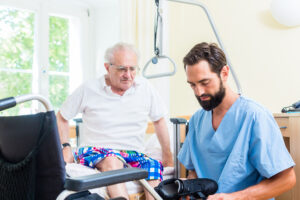How To Safely Help Your Senior Parent With Transferring

Personal care at home can help with various support for aging seniors including safely transferring from bed.
If you’re taking care of a senior parent, one of the things that you may need to help them with as they get older is transferring. Transferring is really just helping your mom or dad get from one place or position to another. Common transfers that seniors need help with are:
- Getting out of bed and into a chair or wheelchair
- Moving from a chair or wheelchair to a toilet
- Standing up from a sitting position
- Laying down in bed from a standing or sitting position
Your mom or dad may need help with transferring because of an injury from a fall, a chronic condition, or an illness like Parkinson’s disease.
Helping your mom or dad transfer can be dangerous for both of you. If you aren’t using the right transfer methods, you could strain your back, shoulders, or neck or injure yourself in other ways. If you can’t complete the transfer, your mom or dad could fall or get hurt.
If you’re nervous about trying to help your mom or dad transfer or if your mom or dad is much larger than you are, it’s a good idea to get personal care at home services for your mom or dad. With personal care at home, your mom or dad will get help from a professional caregiver who has tools and experience that can help them safely transfer your mom or dad.
When you are helping your mom or dad transfer, use these personal care at home tips to protect them and protect yourself from injury:
Learn Proper Body Mechanics
When you’re helping your senior parent, the way you move your body matters. Poor technique can lead to back pain, muscle strains, or injuries. Follow these tips for proper body mechanics:
- Keep your back straight and avoid twisting it during the transfer.
- Bend your knees and use your leg muscles to lift, not your back.
- Stand close to your parent to minimize the strain on your body.
- Keep your feet shoulder-width apart for balance and stability.
And if you are not sure whether or not you can bear all of your senior parent’s weight, either get professional help from personal care at home providers or use a tool like a Hoyer lift to help you.
Use Transfer Aids When Needed
Transfer aids can make the process of moving your senior parent safer and easier for both of you. These tools are designed to reduce strain on your body and provide extra support for your parent. Some common aids include:
- Transfer belts: These wrap around your parent’s waist, giving you a secure handle to hold during the transfer.
- Sliding boards: These allow your parent to move from one surface to another, such as from a wheelchair to a bed, with less effort.
- Mechanical lifts: For parents with very limited mobility, lifts can do most of the heavy lifting for you.
Using the right type of transfer tool can make a significant difference, especially if your parent needs help with transferring multiple times every day.
Communicate and Plan the Transfer
Before starting, talk to your mom or dad and explain the steps of the transfer in detail. Good communication helps ensure you’re both on the same page. For example, you might say, “I’m going to help you stand up now. On the count of three, push with your arms, and I’ll boost you.”
Encourage your mom or dad to do as much as they can to help during the transfer. If they can push, pull, or hold onto something, it reduces the effort required from you. Move slowly and avoid rushing. A planned, steady approach prevents accidents and keeps both of you safe.
If you or someone you know needs Personal Care at Home in Gulf Shores, AL, please contact the friendly caregivers at Hughes Home Care. We provide quality and affordable care for your elderly loved ones in our community. Serving Mobile & Baldwin County. Call us today at (251) 517-9901
- Risk Factors that Increase the Likelihood of Heart Failure - April 11, 2025
- Is it Possible for Seniors to Eat 30 Plants a Week? - March 25, 2025
- Healthy Aging: Why Remaining Active Matters - March 7, 2025
